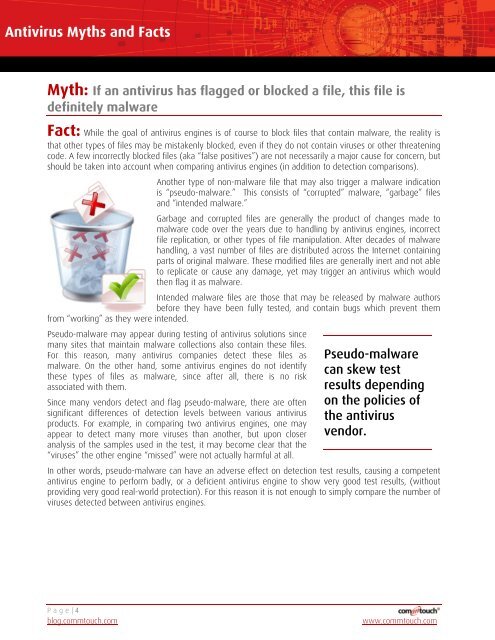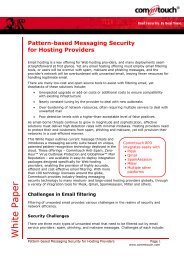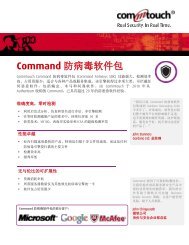<strong>Antivirus</strong> <strong>Myths</strong> <strong>and</strong> <strong>Facts</strong>\Myth: If an antivirus has flagged or blocked a file, this file isdefinitely malwareFact: While the goal of antivirus engines is of course to block files that contain malware, the reality isthat other types of files may be mistakenly blocked, even if they do not contain viruses or other threateningcode. A few incorrectly blocked files (aka “false positives”) are not necessarily a major cause for concern, butshould be taken into account when comparing antivirus engines (in addition to detection comparisons).Another type of non-malware file that may also trigger a malware indicationis “pseudo-malware.” This consists of “corrupted” malware, “garbage” files<strong>and</strong> “intended malware.”Garbage <strong>and</strong> corrupted files are generally the product of changes made tomalware code over the years due to h<strong>and</strong>ling by antivirus engines, incorrectfile replication, or other types of file manipulation. After decades of malwareh<strong>and</strong>ling, a vast number of files are distributed across the Internet containingparts of original malware. These modified files are generally inert <strong>and</strong> not ableto replicate or cause any damage, yet may trigger an antivirus which wouldthen flag it as malware.Intended malware files are those that may be released by malware authorsbefore they have been fully tested, <strong>and</strong> contain bugs which prevent themfrom “working” as they were intended.Pseudo-malware may appear during testing of antivirus solutions sincemany sites that maintain malware collections also contain these files.For this reason, many antivirus companies detect these files asmalware. On the other h<strong>and</strong>, some antivirus engines do not identifythese types of files as malware, since after all, there is no riskassociated with them.Since many vendors detect <strong>and</strong> flag pseudo-malware, there are oftensignificant differences of detection levels between various antivirusproducts. For example, in comparing two antivirus engines, one mayappear to detect many more viruses than another, but upon closeranalysis of the samples used in the test, it may become clear that the“viruses” the other engine “missed” were not actually harmful at all.Pseudo-malwarecan skew testresults dependingon the policies ofthe antivirusvendor.In other words, pseudo-malware can have an adverse effect on detection test results, causing a competentantivirus engine to perform badly, or a deficient antivirus engine to show very good test results, (withoutproviding very good real-world protection). For this reason it is not enough to simply compare the number ofviruses detected between antivirus engines.Page| 4blog.commtouch.comwww.commtouch.com
<strong>Antivirus</strong> <strong>Myths</strong> <strong>and</strong> <strong>Facts</strong>\Myth: Third Party evaluations of AV engines are more accuratethan tests run by AV vendorsFact: The testing <strong>and</strong> evaluation of antivirus software has always been a challenge. Test results are, ofcourse, dependent on the knowledge <strong>and</strong> motivation of the tester. However, much of the value of the testlies in the quality of the test set of virus samples.Most testers for publications or other third-party testing organizations have built impressive malwarecollections over time. Since these testers or organizations are not, however, necessarily part of the antiviruscommunity, they often rely on questionable sources for their samples <strong>and</strong> their test sets often contain a highpercentage of old viruses. The types of files used in testing can skew test results, as described in theprevious section, obscuring which antivirus engine truly has the bestdetection.Anti-malware vendors have different motives for their testing thanthird-parties, since they typically want to ensure that their productsappear in the best light. On the other h<strong>and</strong>, antivirus vendors knowexactly how to test <strong>and</strong> have the means to build a variety of highquality test sets. Many vendors receive over 10 million samples peryear that they can use as part of their test sets.Since a truly objective test of antivirus products is virtually impossible,what can be done to get a sense of an engine’s capabilities? Areasonable impression of the true quality of a solution requireschecking how well a product does in a real environment, <strong>and</strong> inparticular with new viruses. A good option is a site like virustotal.com,Test results aredependent on theknowledge <strong>and</strong>motivation of thetester, <strong>and</strong> thetest samples.where people submit suspicious files on a daily basis <strong>and</strong> have the files scanned by a multitude of virusscanners. If a virus is detected by just one engine, it is often a false positive. If it is detected by ten or moreengines then it is probably malware. It should be noted that VirusTotal uses comm<strong>and</strong> line scanners, whichmay not fully reflect the normal operation of the products from each of the companies. Of course, the onlyway to know for sure that something is malware is to run it in a fully protected environment <strong>and</strong> have aqualified virus analyst verify the malicious behavior.Companies determined to do their own testing should start with a visit to the web site of the Anti-MalwareTesting St<strong>and</strong>ards Organization (AMTSO, www.amtso.org). This organization defines guidelines <strong>and</strong> bestmethods <strong>and</strong> approaches for malware testing. Also, if you are doing your own independent testing <strong>and</strong> getresults that look strange (e.g. the product detects only a subset of your samples), it is best to contact theantivirus vendor <strong>and</strong> ask them to assist in determining whether anything is wrong with the testingmethodology or sample set. You will find that in most cases antivirus vendors will be happy to evaluate yourapproach <strong>and</strong> test set.<strong>Antivirus</strong> vendors cannot provide you with a virus sample set to test since antivirus community agreementsprohibit this. However, it is perfectly acceptable for antivirus vendors to receive a sample set from the publicto determine whether the set is suitable for testing, <strong>and</strong> whether the testing approach needs to be modifiedto get more objective results.Page| 5blog.commtouch.comwww.commtouch.com








